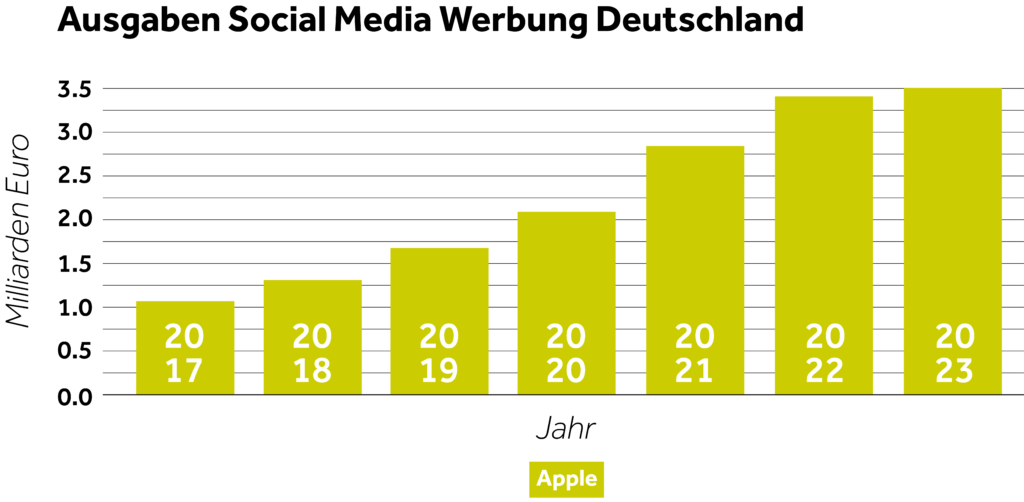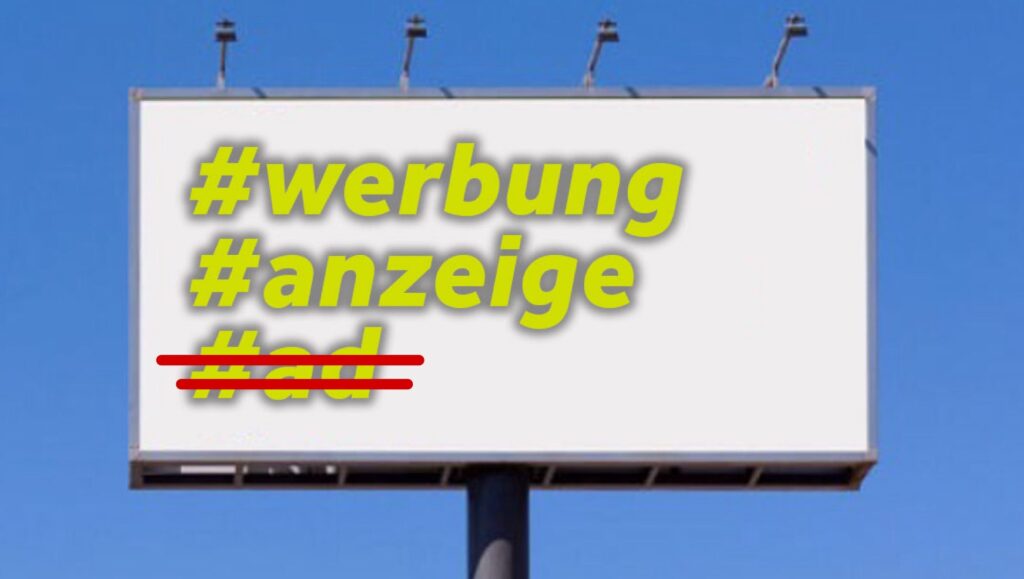
Advertising labeling on Instagram
Advice on advertising labeling for Instagram: Take the opportunity of an individual consultation to legally secure your social media strategies. Contact us for more information.
#socialmedia
#werbung
#kennzeichnung
#anzeige
Table of contents
With spending of over 3.5 billion euros on social media advertising in Germany alone in 2023, the obligation to label advertising on Instagram, TikTok, Snapchat & YouTube should not be underestimated. In the USA, over 66 billion euros were spent on advertising on Instagram & Co. in 2023. A gigantic market has emerged. There are several hundred thousand influencers in German-speaking countries alone. Many of them earn their living from advertising on their channels.

“But not all advertising is the same...”
… and the background is not always immediately recognizable.
Both companies and influencers must comply with certain rules.
Please note: a lack of consumer protection can result in hefty fines . We have already successfully assisted in numerous such cases.
You could get off lightly for individual posts, but repeat offenders can be fined up to €15,000. We therefore explain everything you need to know about correct advertising labeling on Instagram and all other social media channels.
Before we get down to the nitty-gritty: This article is intended to provide general information about advertising labeling obligations and does not constitute legal advice in individual cases. If you have a specific concern on this topic, you should definitely arrange an individual consultation.
Definition of advertising labeling on Instagram, TikTok, Snapchat, etc.
First of all, the important question arises: What is considered advertising and when do I have to label it? Basically, advertising is any clearly recognizable highlighting. This includes showing products, mentioning brand names or other forms of highlighting. Discount codes or links on product pages, whether in the description, through fade-ins or markings, can also count as advertising and may then have to be labeled.
However, if you only link to a brand’s Instagram account, it is only considered advertising if you receive something in return. This also applies to product placements in which a product or brand is recognizably placed without a special focus being placed on it.
A small example: if you are wearing a recognizable Nike shirt without mentioning it, you only have to mark it if you have received something in return. If you draw attention to a product without having received anything in return, this is not advertising, but editorial content. This is particularly the case if you publish a product review, for example. It is important that you rate the product in a recognizably neutral way and do not express yourself too positively, otherwise you could be accused of advertising and you may have to prove the opposite. However, the following also applies to such content: as soon as you receive something in return, it is considered advertising.

Neutral posting: not subject to labeling
And what counts as consideration? Simply put, any economic benefit you gain from advertising. First and foremost, this is a financial consideration if you receive money from a company for your advertising. But the provision of material goods is also a consideration, for example if you receive the products to be advertised as a gift. Even services, vouchers or generally anything that you do not receive for the normal price counts as consideration and must be marked as such.
Therefore, “unpaid advertising” can still be considered advertising that requires labeling, even if it is actually unpaid in a purely financial sense. Only if you have not received anything in return do you not have to label your post. However, if you focus too much on a product, this can lead to the assumption that it could be paid advertising. To be on the safe side in such cases, you should definitely keep invoices and hospitality receipts. However, in the event of state prosecution by the state media authorities, the burden of proof naturally lies with the supervisory authority. The principle of “in dubio pro reo” still applies, in case of doubt for the accused.
No consideration
=
No labeling
Legal basis and regulations Instagram advertising labeling
According to the law, advertising is to be understood as a commercial act, which in turn is defined in Section 2 (1) No. 2 UWG. Accordingly, the core of a commercial act is the commercial interest in promoting the sales of a company. The Federal Court of Justice has also already dealt with this. In its first “Influencer Ruling I”, it dealt with the issue of clearly highlighting the commercial interest, among other things. The BGH ruled that the use of tap tags on Instagram to link to a company’s Instagram profile does not constitute clear prominence, whereas linking to a company’s website does. It was also important here that the affected party received something in return for the link.
Legally, the labeling obligation is regulated in Section 5a (4) UWG. This states that the commercial purpose of a commercial activity must be clearly identified. Anyone who violates the labeling obligation can be punished with fines.
Act against Unfair Competition (UWG)
Section 5a Misleading by omission
(4) Anyone who fails to disclose the commercial purpose of a commercial act, unless this is directly apparent from the circumstances, and the failure to disclose is likely to induce the consumer or other market participant to make a business decision that he would not have made otherwise, shall also be deemed to be acting unfairly. A commercial purpose does not exist in the case of an act in favor of a third-party company if the person acting does not receive or is not promised any remuneration or similar consideration for the act from the third-party company. The receipt or promise of consideration is presumed unless the person acting credibly demonstrates that they have not received such consideration.
However, these are not the only regulations that need to be observed. The UWG, or Unfair Competition Act, can only be used as a basis for other competitors or interest groups (i.e. competition associations or consumer protection centers). In other words, direct competitors or competition associations can take action against you and demand that you cease and desist.
The state media authorities also act as supervisory authorities. They cannot fall back on the UWG in the event of infringements. Instead, they derive their responsibility and their basis for authorization from the Interstate Media Treaty. This contains a number of regulations on correct advertising labeling, from which the media authorities derive their responsibility. The resulting requirements with regard to labeling obligations are the same, but the focus of the standards is slightly different; it is a matter of state supervision.
Types of advertising labeling on Instagram and other social media platforms
The question now arises as to what correct advertising labeling looks like. In most cases, this must always look the same. The safest option is to clearly write “Advertising” or “Advertisement” in the caption at the beginning of the description. You don’t have to use capital letters for this, but it doesn’t hurt either. The insertion of “Paid advertising partnership” by Instagram itself is also permitted.
BUT NOT “#AD”: English terms such as “Ad” are not sufficient. There are court rulings on this, for example from the OLG Celle(OLG Celle, 08.06.2017 – 13 U 53/17 – openjur.de). Labels at the end of the description or under the hashtags are also not sufficient. The legislator requires that the notice must be “immediately eye-catching” before you learn anything about the product or service.
Incidentally, the specific type of advertising labeling does not depend on the platform, but on the format. This means that the same rules apply for a video on Tiktok or a short on YouTube as for a reel on Instagram or Snapchat. The same rules apply to a photo post on Tiktok as on Facebook or Instagram, whereby a label at the beginning of the post description is also sufficient here, as this is also displayed in the post.
Additional rules apply to regular YouTube videos. Here too, an insertion in the video is required, or alternatively a clear differentiation of the advertisement from the regular content, for example by means of an announcement. Advertising in the video description, even for the same product, must also be marked as “advertising” or “advertisement” in the immediate vicinity of the advertisement.

Advertising, Advertisement, Paid advertising partnership
Specific labeling methods
In the case of advertising in the image, for example in a story post, “Advertisement” or “Ad” must be clearly legible. “Ad” is not sufficient here either. In addition, the word must be visible in full and in a different color than the background, and it must not be too small. A small note: As the beginning of the description is always directly visible in reels, the note at the beginning of the description is also sufficient for advertising in the image.
Correctly labeled Instagram advertising


These are the correct types of advertising labeling on Instagram, TikTok , Snapchat & Co, there is not much leeway.
Special cases of advertising labeling
Does self-promotion have to be labeled?
The situation is slightly different for self-promotion. In principle, you do not have to label these as you do not receive anything in return. However, this is only the case if it is recognizable as OWN advertising. The clearest way to do this is to advertise a product or brand with the same name as your channel. You can also explicitly state in the post itself, in the description or in your channel biography that the advertised product or brand belongs to you. Again, outsiders should be able to establish the connection directly.
If this is not the case, you must label the advertising as usual, according to one or the other state media authority.
However, we take a different, far more liberal view here and have already had one or two “disputes” with the supervisory authorities in this regard. We are of the opinion that the labeling as “advertising” of own products and services is in no way subject to mandatory labeling. It remains to be seen to what extent case law will develop in the coming years. We will be happy to support you in legal disputes, including in court.
Do private individuals have to label advertising?
The regulations explained so far also apply to private individuals within the same framework. Anyone who receives a consideration for advertising must label it. However, private individuals will not be suspected of advertising so quickly in the case of unmarked posts. There are no specific criteria as to when a profile is considered to be used for private or business purposes. The relevant authorities usually assume that this is the case once a certain number of followers has been reached. Verification is also usually seen as an indication of business use. A profile set to private is therefore more likely to be recognized as such, but there is no clear legal regulation here either.
Best practices and recommendations
If you advertise or want to advertise on your channels, make sure you remember the basic formula: If you receive something in return, you must label the advertising. This does not apply to self-promotion. In this case, it must be clear from your profile that it is your product. Labelling is not necessary even if the advertising character is clearly recognizable on your profile. However, the requirements for this are so vague that you should not necessarily rely on them.
If you receive a letter from a state media authority or another responsible body and you are not sure whether this is legal or not, do not respond to it directly. If you are threatened with administrative offense proceedings, you also have the right to remain silent. If you find yourself in such a situation, it is best to contact a law firm specializing in the matter directly.
You will soon find a few practical examples of how to do it right and how to do it wrong here in our News section.
Questions about advertising labeling on Instagram?
Do not hesitate to contact us!

As specialized lawyers for social media & advertising law, we offer you tailor-made advice that is specifically tailored to your needs. Click here to find out more or to arrange a consultation. We ensure that your social media activities comply with all legal requirements.
Legal consequences of non-compliance with labeling
Of course, there are now many cases in which the courts have dealt with the issue of advertising on social media. Even the Federal Court of Justice has already dealt with some cases.
In its Influencer ruling I the BGH stated that the receipt of a consideration is decisive for the labeling obligation. A commercial act can also exist without consideration and then does not have to be labeled. In its Influencer Ruling II, the BGH reaffirmed this point. Here, two influencers were acquitted of the labeling obligation as they had not received any consideration in return despite highlighting a product.
In the Influencer judgment III the outcome was different. In this case, the Federal Court of Justice dealt with the question of what constitutes consideration. Specifically, it concerned an advertising post in which the person concerned advertised a pair of earrings. She did not receive any money in return, she was only allowed to keep the earrings. The BGH considered this to be a consideration and demanded a corresponding labeling and a procedural penalty of € 10,000.
In addition to the question of consideration, the BGH in the Influencer judgment II also addressed the issue of self-promotion. In the two cases covered by the ruling, the two parties concerned had also posted self-promotional posts on their respective accounts without labeling them. In principle, according to the BGH, such posts are also considered commercial activities. However, both accounts were obviously recognizable as commercially used accounts and thus the commercial purpose for self-promotion was also immediately recognizable for the average user. It was therefore also directly recognizable that there was no consideration, which meant that the labelling obligation did not apply. Incidentally, the standard of the average user is laid down by law in Section 3 (4) UWG, but the exact definition of this average user is a matter of interpretation. This is often the subject of dispute in proceedings regarding the sufficient labeling of social media posts.
Conclusion on advertising labeling on Instagram, Tik Tok, Snapchat & Co
The field of influencer advertising on Instagram is not easy to keep track of. Anyone who approaches the matter unprepared can quickly run into major problems. But even those who know their way around have to be careful. The Federal Court of Justice has determined, among other things, what correct advertising labeling should look like and when it should be used. Nevertheless, there is a lot of room for maneuver when it comes to deciding when exactly the respective requirements are met. There may be a ruling that self-promotion that is obviously recognizable as such does not have to be explicitly labeled. However, it has not yet been conclusively clarified when exactly it is obvious and when it is not. If you want to be on the absolutely safe side, you can of course mark every post with “Advertising”. However, this is only necessary if you have received something in return from another company. So if you receive a request from the state media authority responsible for you or another competent body, you should not necessarily comply with it immediately, but should first check the situation more closely. You are welcome to get in touch with us. We will help you.



